6 yoga poses to stretch after a long flight
The best yoga poses to stretch your whole body after a long flight to reduce blood pressure and release tight muscles
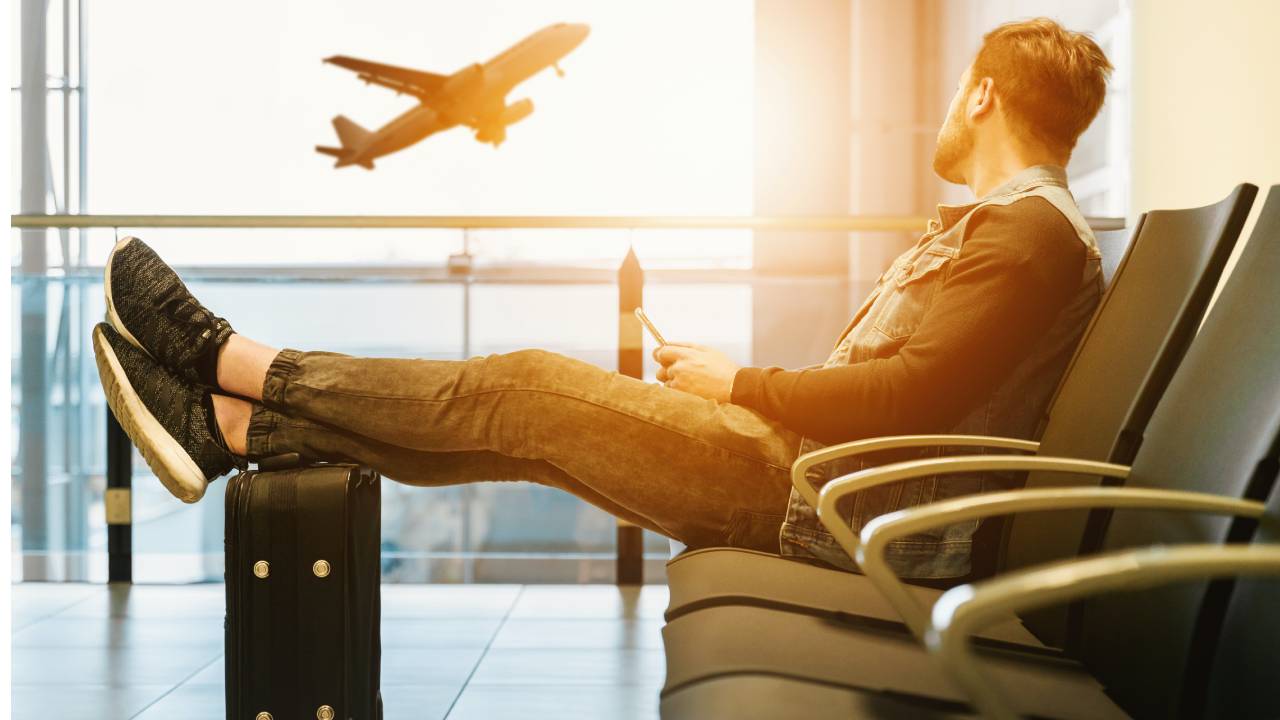
After sitting on a long flight for a number of hours, it’s good to stand and move around. Yoga poses are a great way to stretch the whole body after flying, especially when we get off the flight feeling stagnant and stiff. Yoga poses not only stretch all your muscles but can also help sharpen the mind and energise us, reducing the sluggishness we may feel after in-flight food and lack of movement.
Standing is a simple yet effective way to reduce blood pressure so this yoga sequence will mainly focus on standing postures to counteract all the sitting that will have been done on the flight.
Sitting in compressed ways can cause us to breath more shallowly so I’ve included some postures to stretch the torso and side body to help you take a deeper breath throughout the practice, and to get your lungs working more towards their full capacity. It's also these deeper breaths that will help energise a tired mind, so grab your best yoga mat and let's get started.
1. Standing side stretch

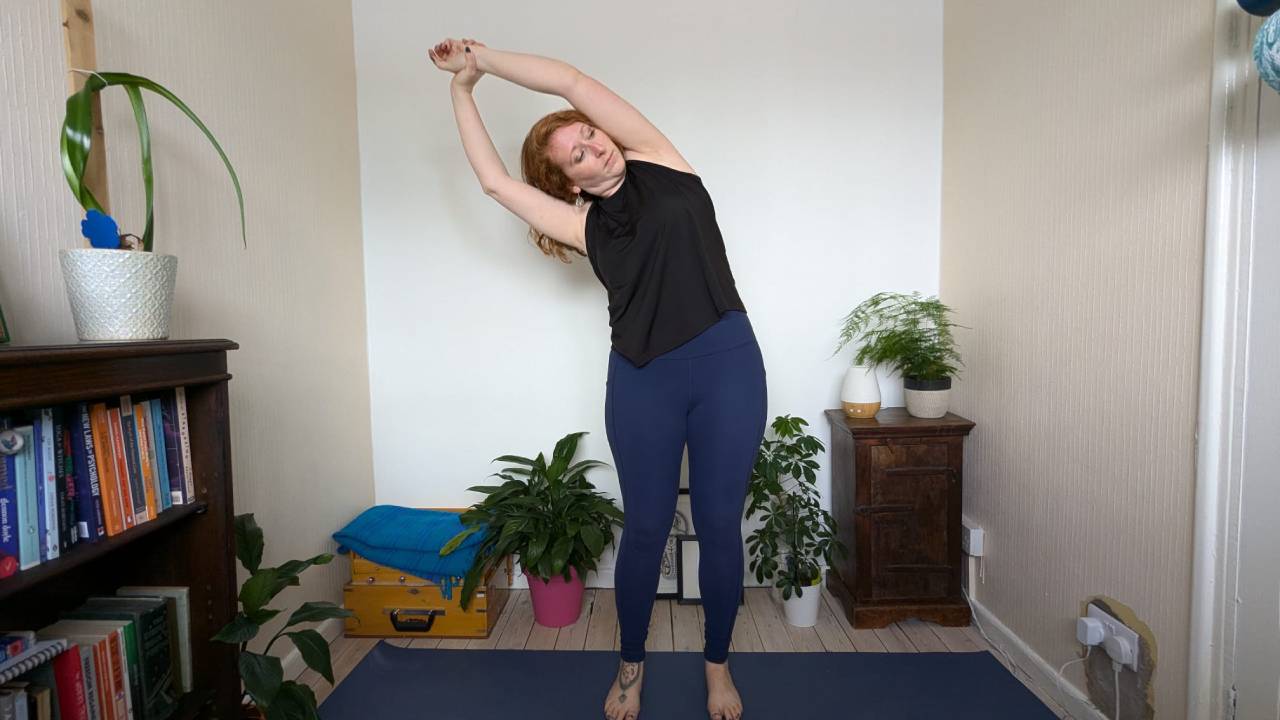
This pose is great for loosening the side body, shoulders, neck, hips and opening the lungs. When we’ve been sat for long periods of time, these are areas that get tight, and that we may forget to move often. This can be difficult enough to remember to do but more so when on a long flight and we don’t want to annoy our neighbours next to us by getting out of our seat regularly.
Stand with your feet either together (if you don’t experience any lower back problems) or hip distance apart. Take an inhale and lift both arms up overhead. Take hold of your right wrist with your left hand and on an exhale, lean your hips to the right and your upper body to the left. Stay for a breath and on an exhale, release. Repeat but this time taking your left wrist in your right hand. Practice this a few times on each side if your shoulders and sides feel particularly tight.
2. Standing forward bend with IT band stretch
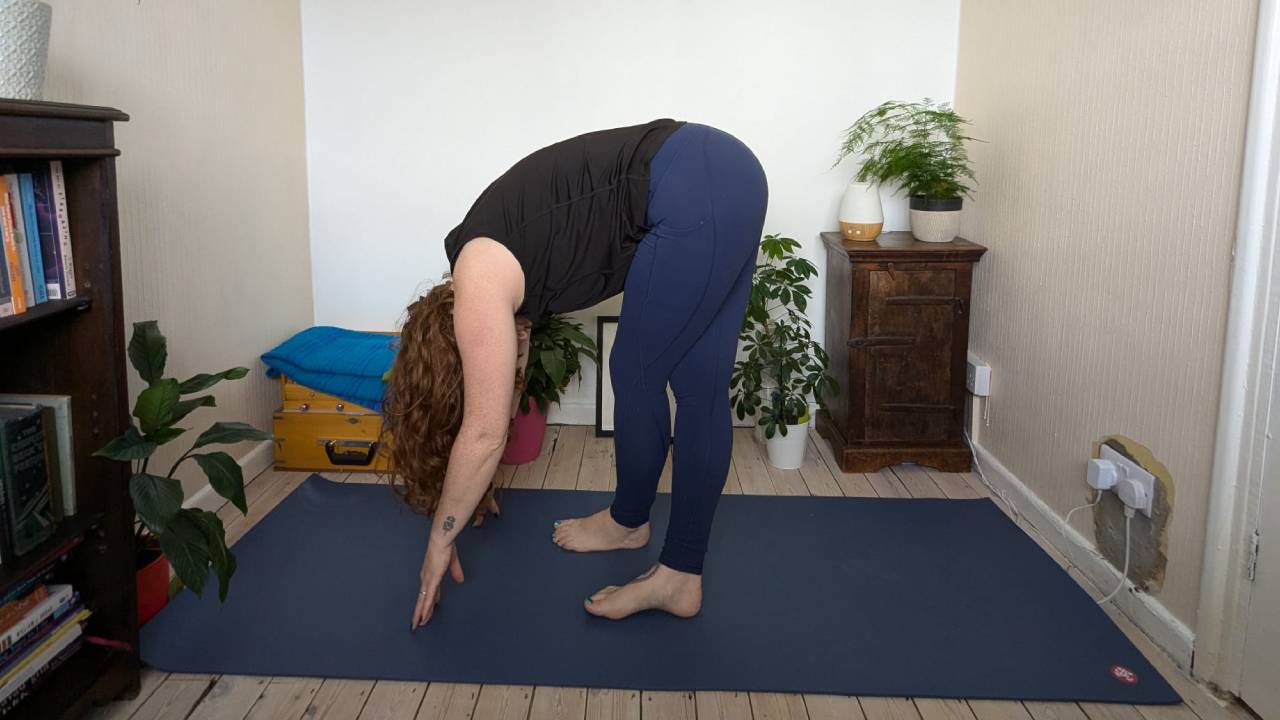
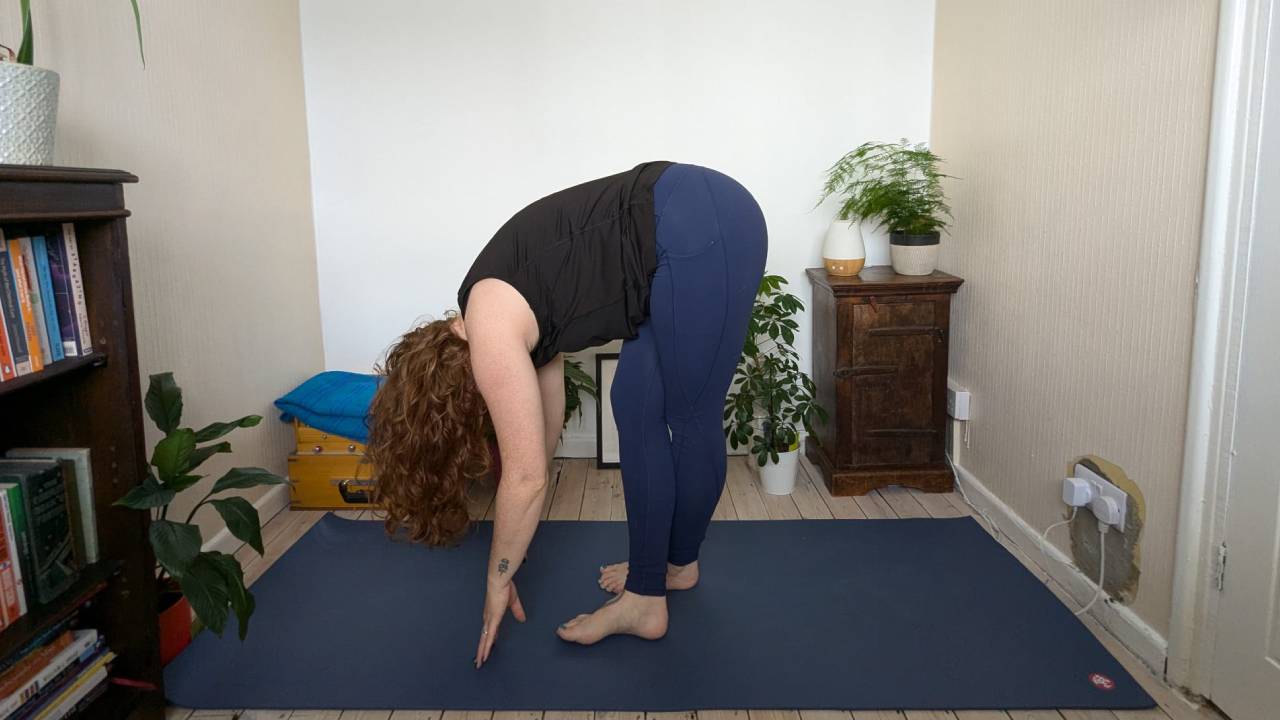
After extended periods of sitting, our hamstrings and lower back can feel contracted and stiff when trying to walk around. Standing forward bends are a great way to loosen the lower back and stretch out hamstrings. This one has the added benefit of including the IT band; another area that can feel rigid without us noticing it.
Stand with your feet hip distance apart. On an inhale, extend your arms overhead and as you exhale, fold forward from your hips. Ensure the fold comes from the crease of the hips and bend your knees as much as you need to. Your hands can rest on your shins, or can touch the floor if you’re more flexible. Take a few breaths. This is the warm up to get ready for a deeper stretch when we involve the IT band. On an inhale, bring your hands to your hips, press into your feet and come up to stand.
Get all the latest news, reviews, deals and buying guides on gorgeous tech, home and active products from the T3 experts
Now, bring your right foot in front of your left so your legs are crossed at the ankles. Keep pressing the mound of your right big toe down into the floor. There can be a space between your feet. Squeeze your inner legs together. Inhale and lift your arms overhead and as you exhale, fold forward again from the crease of the hips. Bend your knees if needed as this can take pressure off the back in this deeper posture. Your hands can find a place on your legs, or even rest your forearms onto your thighs. Take a few deep breaths before placing your hands on your hips, pressing into your feet to come back to stand. Repeat, but placing your left foot over your right.
3. Garudasana arms with cactus arms
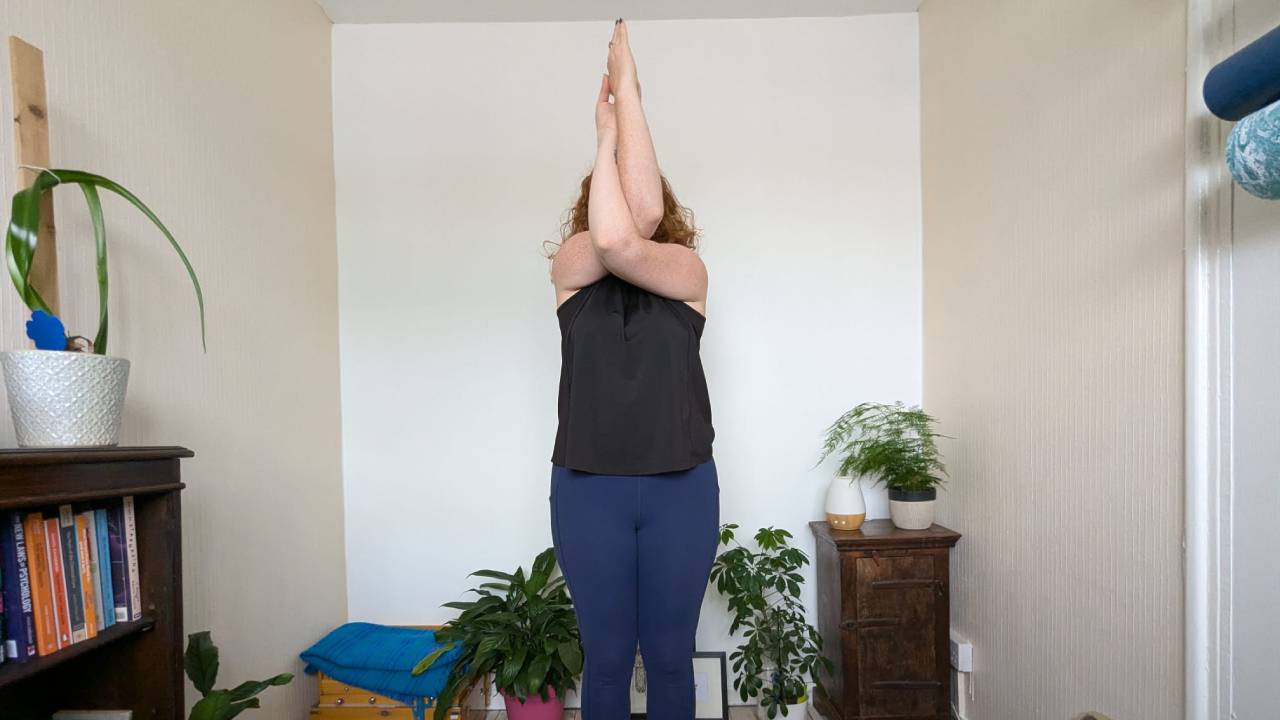
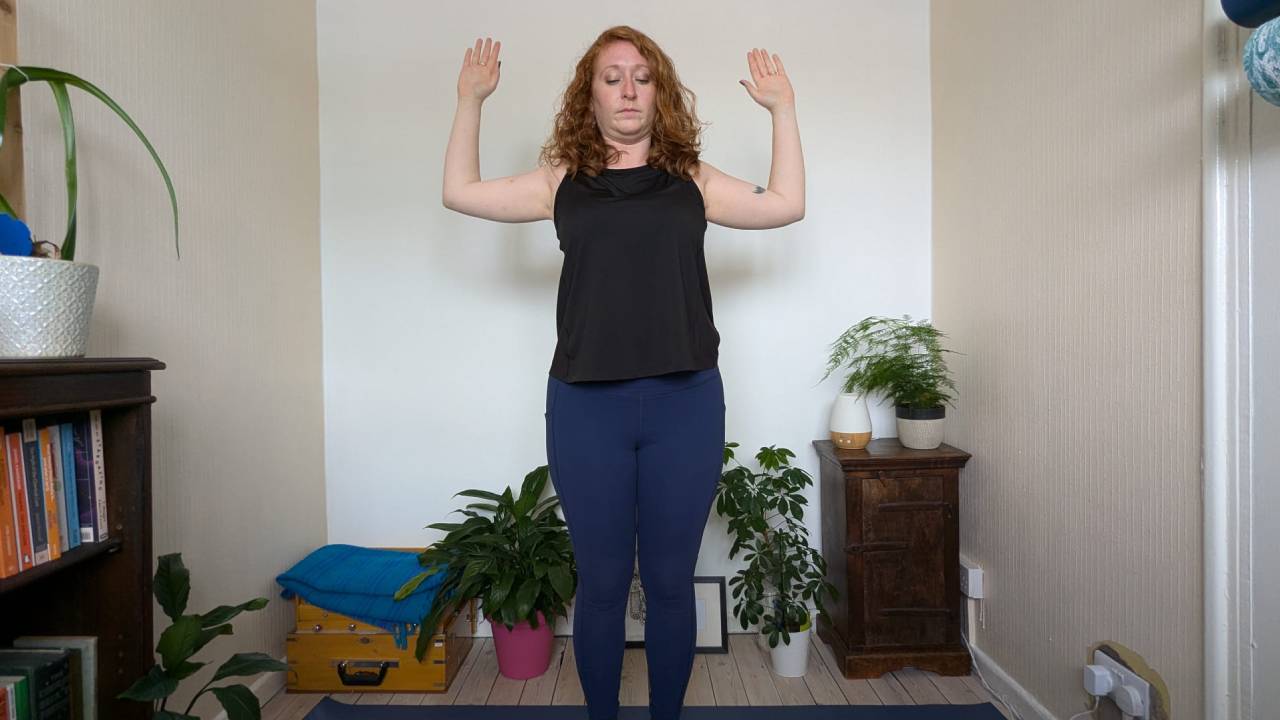
On a long flight, I tend to sit in awkward positions as I struggle to get comfortable and end up hunched in my shoulders. This version of Garudasana (eagle) arms with cactus arms helps open the upper back, create movement in the shoulder blades and opens the chest which can become contracted when we’re sat hunched. This feeling of contraction in the chest can also mean we don’t take deep breaths, relying more on chest breathing than longer belly breaths.
This can be practiced either standing or sitting - you may prefer standing after all the sitting that will have been done on the long flight! Inhale and stretch your arms out to the side at shoulder height. As you exhale, bring the arms across the chest, crossing the right elbow over the left. Bend the elbows and see where your hands end up. If you can, and without strain, you can try to wrap your left arm around the right, taking the right wrist with the left hand. Keep your elbows lifting, shoulder blades move down away from the ears and your hands away from your face; they have a tendency for most people to move towards the forehead. Try and keep your arms parallel to your head. Hold for a few breaths before releasing and opening the arms out to the side again.
Once your arms are out wide, bend the elbows with your palms facing forward. Bring your arms back, trying to squeeze the shoulder blades together. Hold and breathe before straightening the arms and then crossing the arms in front of the chest again, this time bringing the left elbow over the right. Repeat the sequence. You can flow like this for a while if you’re finding it gets easier each time, helping to release tight shoulders.
4. Virabhadrasana 2 - Warrior 2
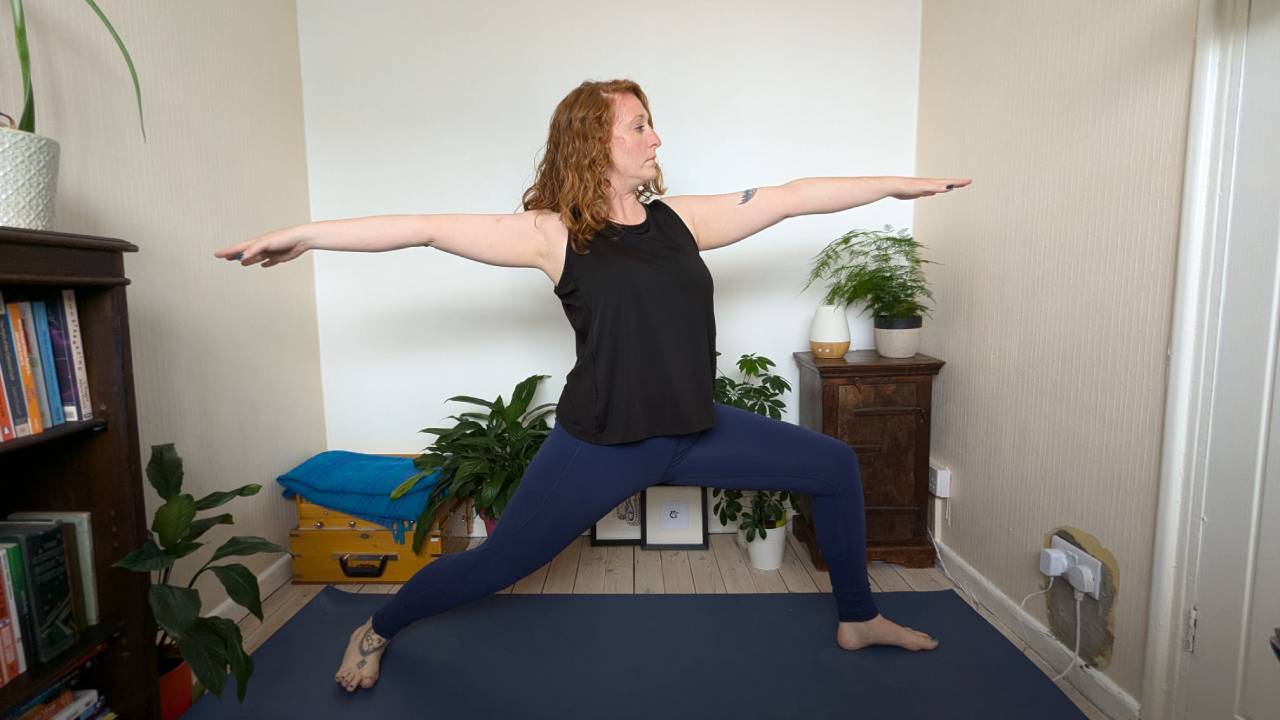
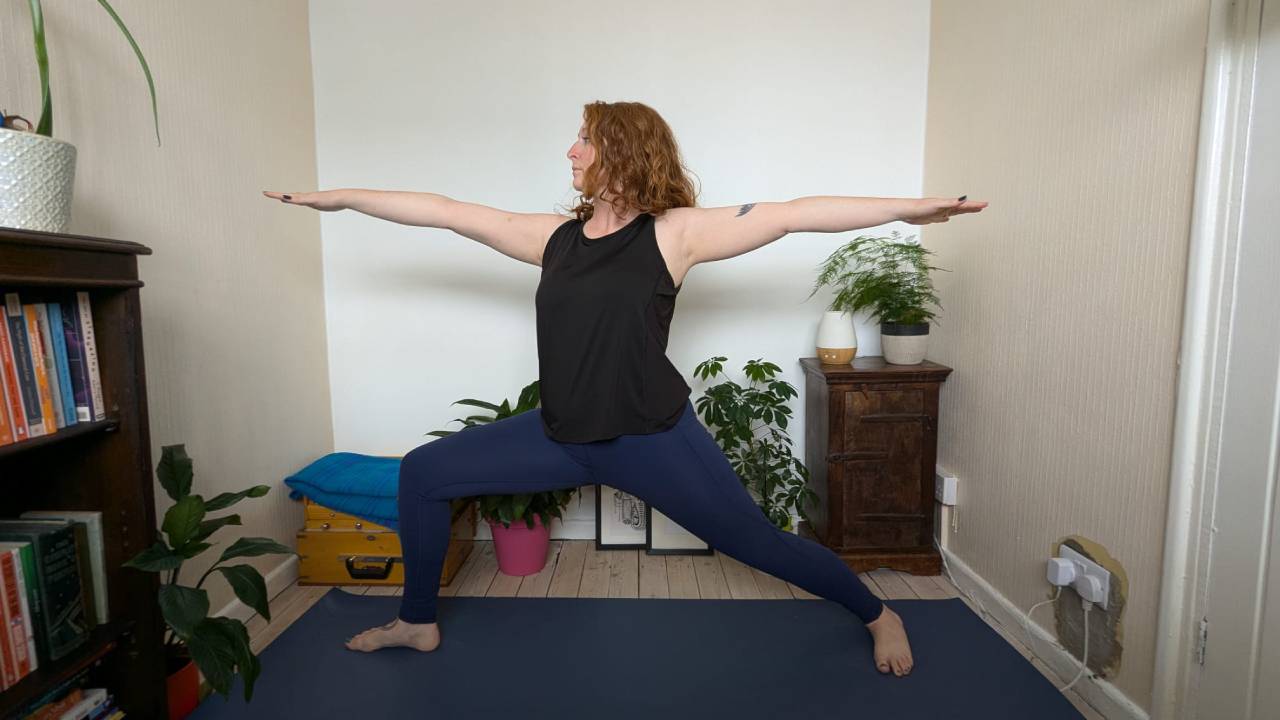
This is a challenging yoga posture but one that allows you to feel the benefits instantly. Being a deep hip opener, Warrior 2 is a strong standing pose which will help you build strength in your legs. This is something you may be feeling you need to wake your legs up after flying.
From a standing position, separate your feet wide facing the long side of your yoga mat. Keep your hips facing the long side of your mat as you turn your right toes to face the short side of your mat. Feel the leg turn out from the hip. Inhale and raise your arms to shoulder height, palms facing down and exhale, bend into your right knee. Rather than lean your weight forward over your right leg, keep your shoulders stacked over your hips and imagine you’re sinking your hips down. Look over your right middle finger.
Take a few deep breaths before pressing into your feet on an inhale and coming back to legs straight. Release your arms and turn your right toes in and left toes out to the short side of the mat. Repeat your Warrior 2 on the left side.
5. Triangle pose
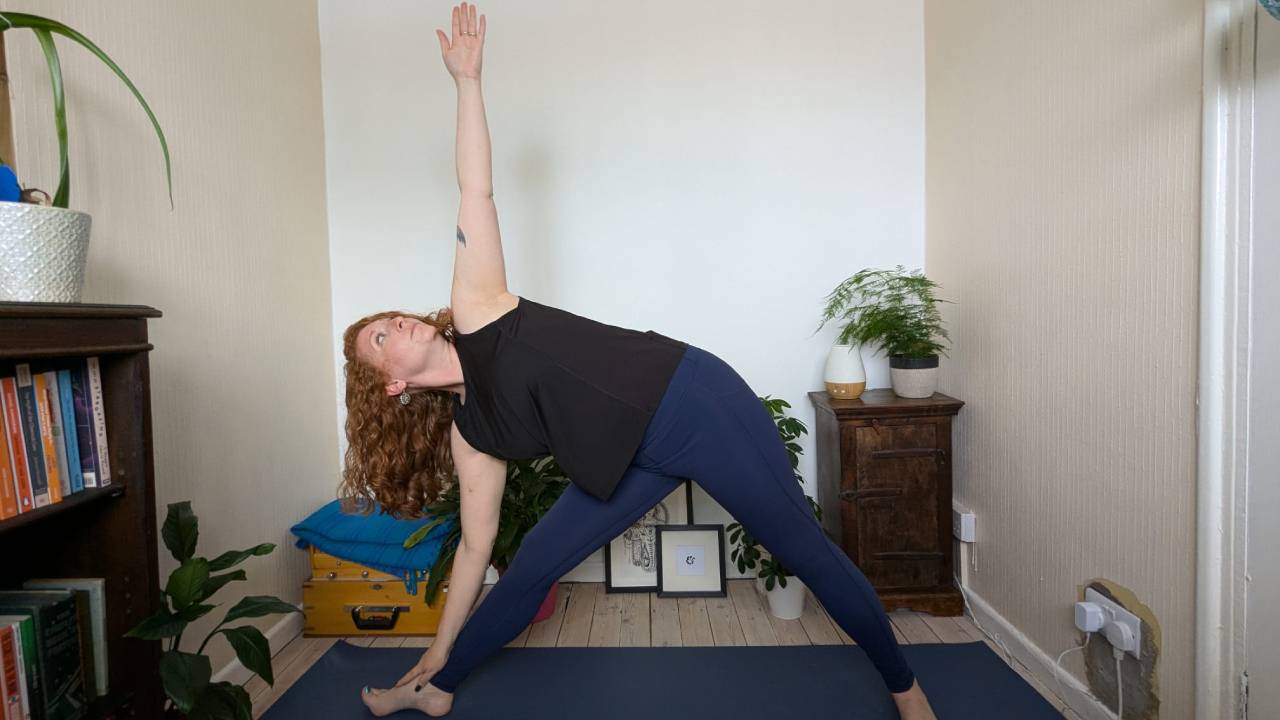
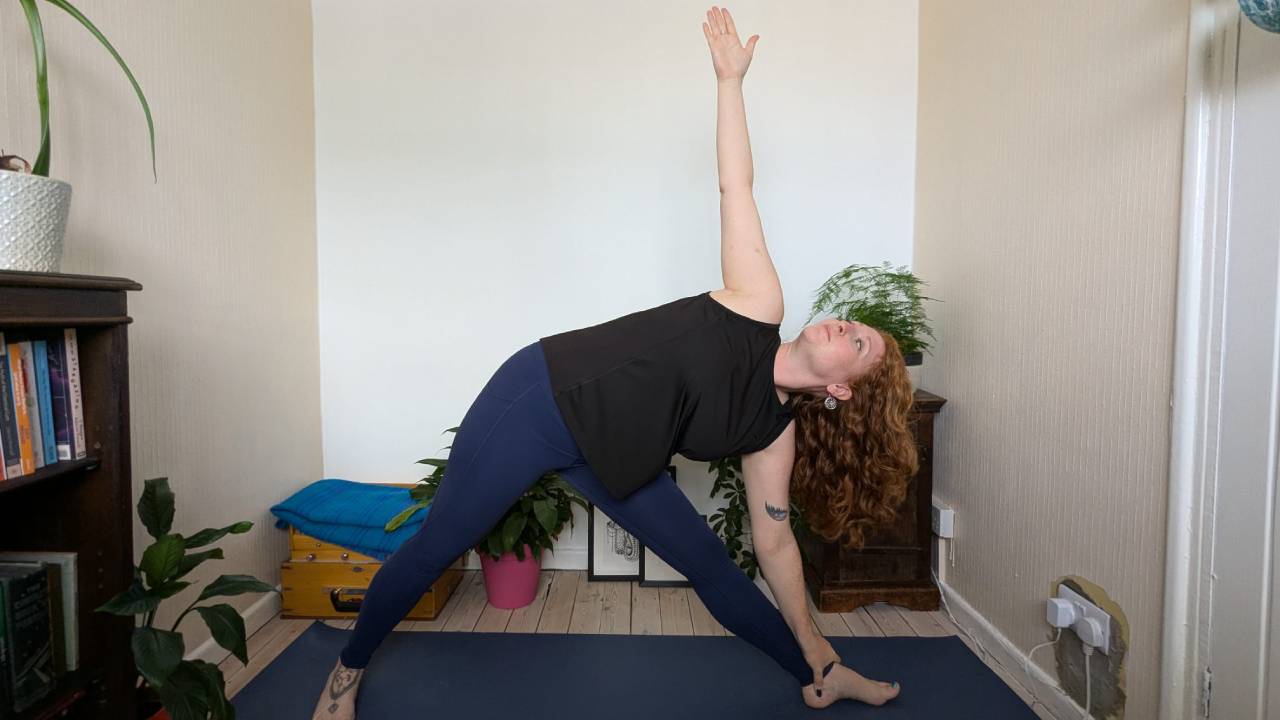
As a final release for your side body and expansion for your lungs, triangle pose will help target any tight spots in your torso, shoulders, chest as well as opening the inner thighs, hips and hamstrings. Triangle pose is a magical posture that helps soften the whole body once practiced.
From your wide legged standing position, turn your right toes to the short side of your mat and inhale, lift your arms to shoulder height. Keeping your legs straight, exhale and reach over your right leg with your right arm. Inhale again and on your next exhale, let your right hand come down to your right leg wherever it reaches. Lift your left arm, fingers pointing to the ceiling. Turn your right ribs forward and roll your left ribs back to open the chest. Check both your shoulder blades are sliding away from your ears.
Take a few deep breaths before inhaling, pressing firmly into your feet to lift back to the starting position. Release your arms and turn your right toes in and your left toes to the short side of the mat. Repeat triangle pose on the left side.
6. Firelog pose
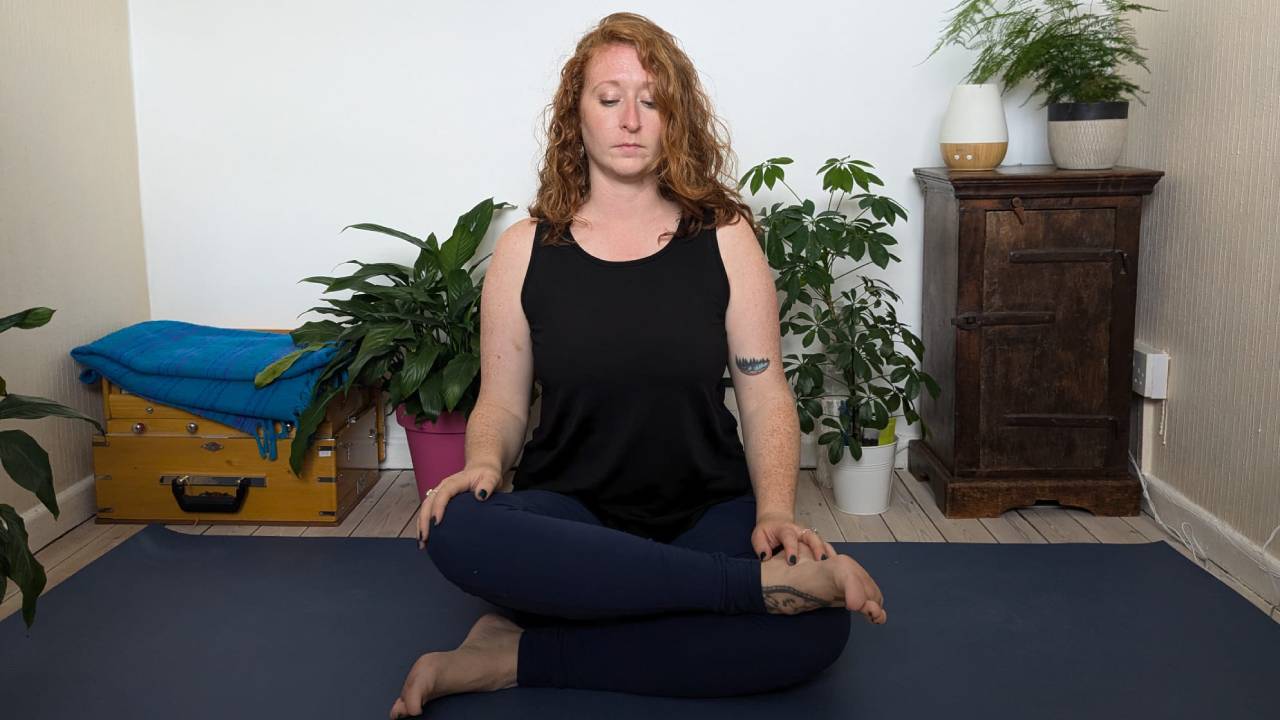
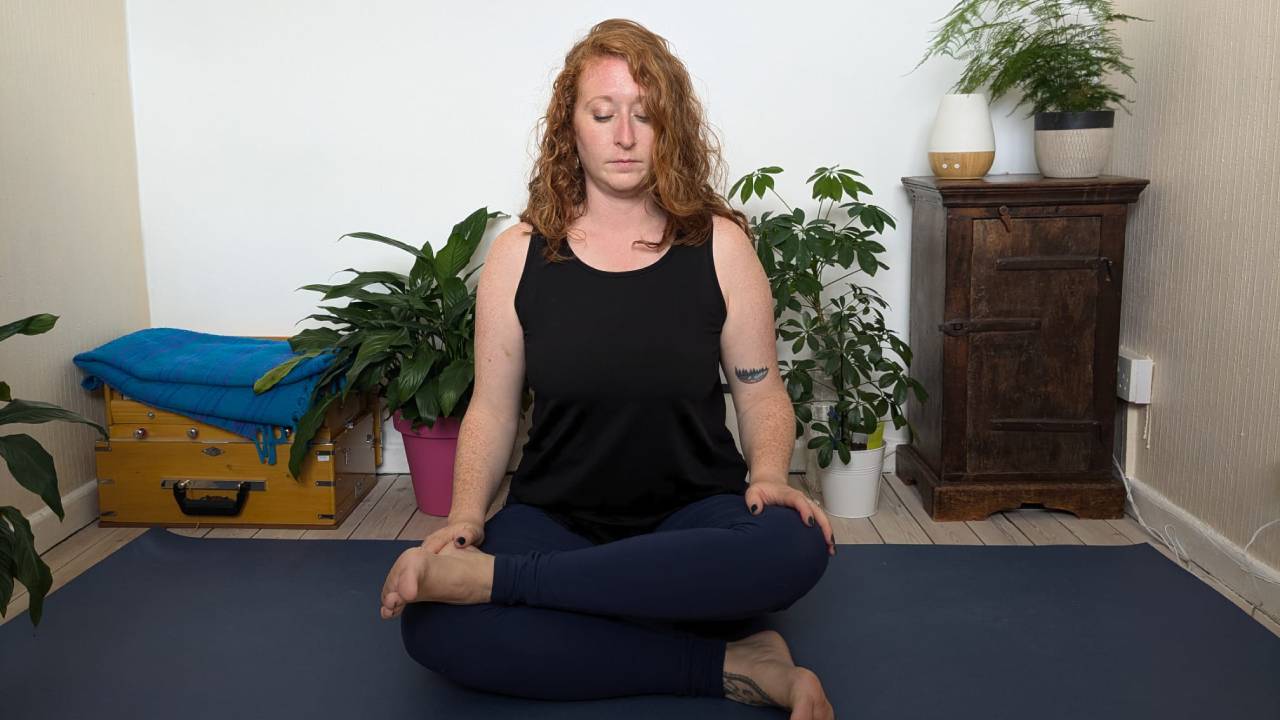
Coming to the floor and heading towards relaxation, we have firelog pose which is amazing for softening the outer hips, glutes and lower back. This is a challenging position so if it’s not easily available to you, do not push it and instead take a simple cross legged position instead. This could be exactly what your body needs so there’s no need to push into the harder variation just because. Firelog pose helps to promote movement through the hips and can reduce aches and pains we may experience after periods of sitting for a long time.
Sitting on the floor, bring yourself into a cross legged position with your right leg crossed in front of your left. With your hands, help bring your right leg on top of your left, ensuring your left leg remains parallel to the edge of your mat. Place your right ankle on your left knee and your right knee over your left ankle. You’re looking for a triangle shape between the legs. Inhale and exhale here allowing your knees to soften.
You can sit on a yoga block to help lower the knees which want to be lower than the hips for this pose to be accessible to you. If sitting on a block still doesn’t help the knees to be lower than the hips or you struggle to sit up straight without a lot of effort, consider taking the cross legged position you started in instead. Once you’re ready to move out of this posture, use your hands to lower the right leg in front of the left again and then cross your legs the other way. Repeat firelog pose with the left leg on top.
Kat has 10 years of yoga teaching experience with further training in supporting injured students. She is qualified to teach Yin Yoga, Hormone Yoga Therapy and more traditional forms of Hatha yoga. She also has a certificate as a Yoga Therapy Practitioner.